Round out your week with these stunning infrared views of the universe from the James Webb Space telescope.
Jupiter in a New Light
Some of the first Webb images released (albeit with less fanfare, in the technical documentation) included Jupiter. Infrared light showed a new view of the planet, its gauzy rings, and surrounding moons. Now, images captured on July 27th have revealed unprecedented detail.
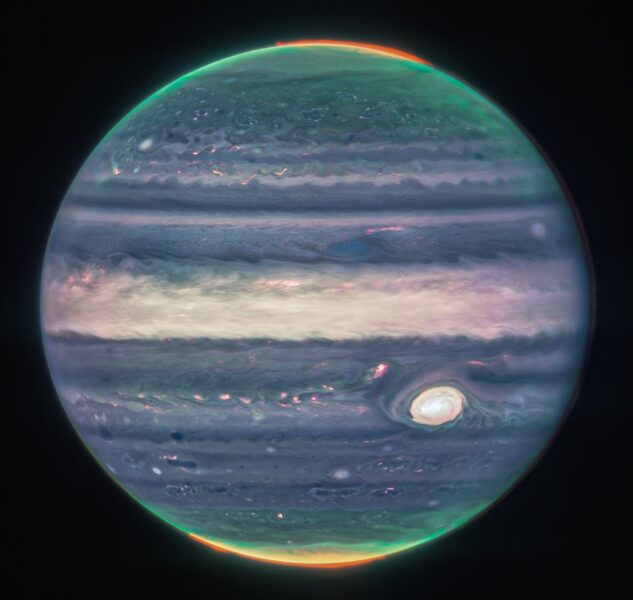
NASA / ESA / Jupiter Early Release Science team; Image processing: Ricardo Hueso (UPV / EHU) and Judy Schmidt
"We've never seen Jupiter like this," says Imke de Pater (University of California, Berkeley), who co-led the scientific observations. “It’s all quite incredible.” Even in the details we’ve known of before — such as the detached layer of haze that sits above the cloudtops — Webb’s infrared view gives a new perspective.
Amateur astrophotographer Judy Schmidt (aka @SpaceGeck), who helped process the image along with Ricardo Hueso, chose red-orange, yellow-green, and cyan to display the Jupiter data instead of a pure red-green-blue palette. “I think of every image as a puzzle, so every time I process them, it's a little different,” she adds.
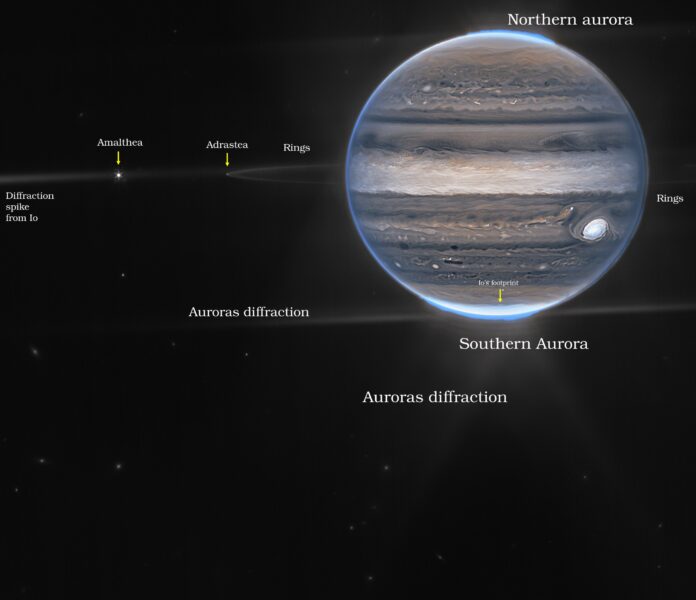
NASA / ESA / Jupiter Early Release Science team; Image processing: Ricardo Hueso (UPV / EHU) and Judy Schmidt
Other details to look for in the image are the reddish auroras (with emission from ionized hydrogen) and green high-altitude hazes at both poles. The nearly transparent rings that circle the planet are 1 million times fainter than the planet itself, showcasing Webb’s dynamic range.
The image also shows the Great Red Spot (white in the image) as well as several smaller storms (also white). Webb also clearly shows the transition from the stripes familiar to amateur astronomers to the chaotic whirls at the poles that NASA’s Juno spacecraft has seen. (Diffraction from bright objects, such as Jupiter’s auroras and the moons, are also visible as horizontal smears of light.)
Carbon Dioxide on a Puffy Planet
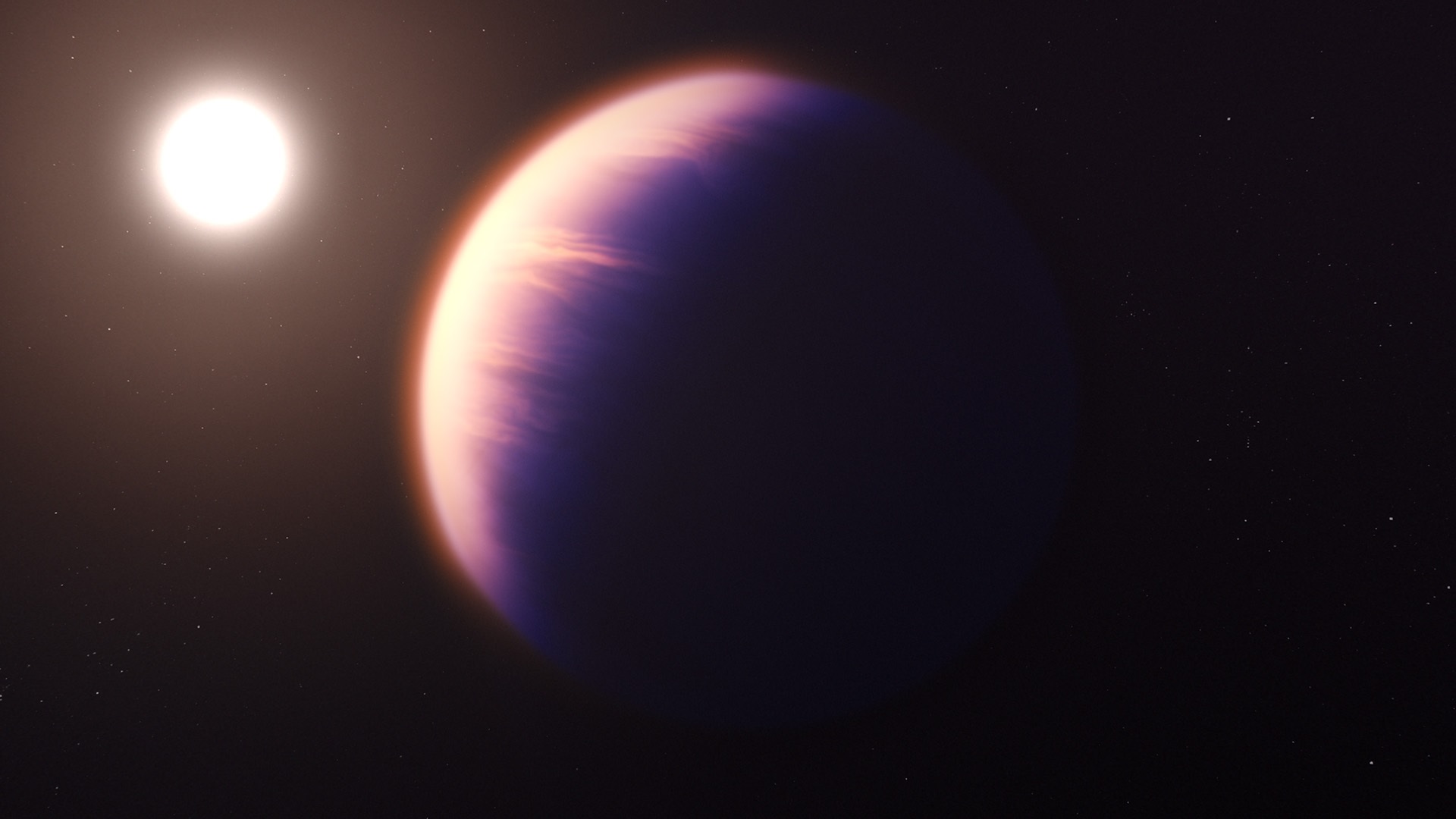
NASA / ESA / CSA / J. Olmsted (STScI)
WASP-39b is a “super-puff,” just like the first exoplanet Webb observed (WASP-96b). While it has about the same mass as Saturn, its girth stretches as wide as Jupiter’s. And like other such planets, it orbits its star every four days. It’s probably puffy because of that proximity, which brings its temperature to a searing 900ºC (1600ºF).
Now, in new data from the James Webb Space Telescope, astronomers have looked inside this planet’s atmosphere and seen the chemical fingerprint of carbon dioxide in its atmosphere.
Sara Seager (MIT), who wasn’t involved with the study, says the signal is exceptionally strong compared to what researchers who study exoplanet atmospheres are used to. “I think people are so happy because it's unprecedented to have such a strong signal in an exoplanet atmosphere transmission spectrum,” she says.
“Detecting such a clear signal of carbon dioxide on WASP-39 b bodes well for the detection of atmospheres on smaller, terrestrial-sized planets,” says team lead Natalie Batalha (University of California, Santa Cruz).
The study raises more questions than it answers, points out Adam Burrows (Princeton), who also wasn’t involved in the study. “No brown dwarf, solar-system giant, or ice giant . . . has any detected carbon dioxide in its atmosphere,” he says. So that begs the question, why do we see the molecule on this hot, super-puff planet?
The study will be published in Nature next week, but there will be more to come on this planet and others like it. The present study, for example, required some simplifying assumptions for fitting the model to the data; future studies will more fully explore the data and its implications.
Galactic Maelstroms
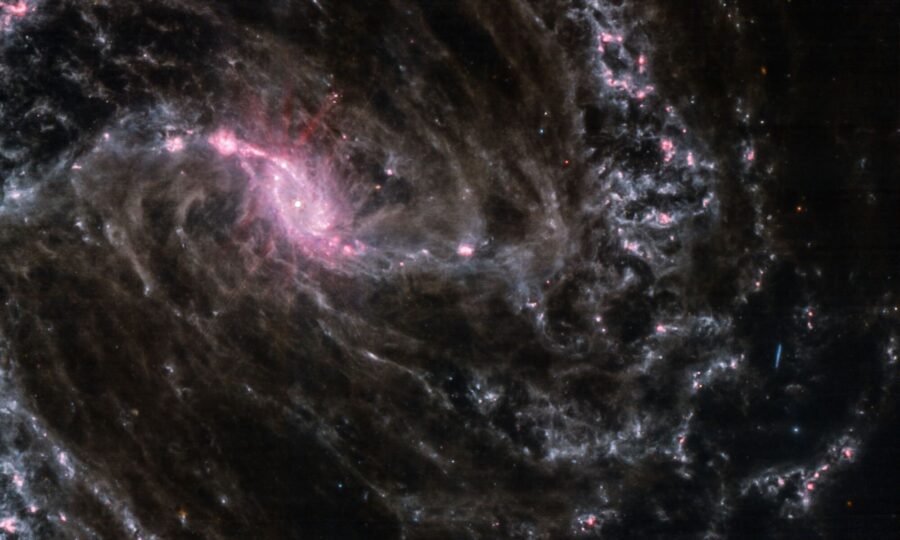
NASA / JPL-Caltech / Judy Schmidt
Hubble Space Telescope images show NGC 1365 as a double-barred spiral galaxy roughly twice the size of the Milky Way some 56 million light-years away in Fornax. Webb’s mid-infrared view offers an entirely different perspective on the galaxy, since we’re seeing the light from warmly glowing dust, not newborn stars. The main, star-filled bar becomes less prominent and the second, dusty bar comes into clearer view.
The galaxy also has a central supermassive black hole. It’s half the mass of the Milky Way’s, but unlike our own behemoth, this one is actively feeding and as a result stands out as if it were a brilliant single star. But what we’re actually seeing is dust around the black hole, lit by the intense ultraviolet radiation from hot gas sliding into the dark maw. The bars may play an essential role in sending gas into the galaxy’s center.
The observations of NGC 1365, taken as part of the Physics at High Angular resolution in Nearby GalaxieS (PHANGS) Survey, also include near-infrared observations. Schmidt posted an animation of both views that shows a haze of stars in the near-infrared view give way to the web of dust revealed at mid-infrared wavelengths:
“I'm always trying new ideas as long as I can think of them,” Schmidt says. “I don't let myself get stuck with one way of working or give up if it doesn't work the way I hoped it would on the first try.”
For her part, Schmidt’s favorite (so far!) is the image of the large spiral galaxy NGC 628, also known as Messier 74. “It's so different and kind of eerie looking,” she says.
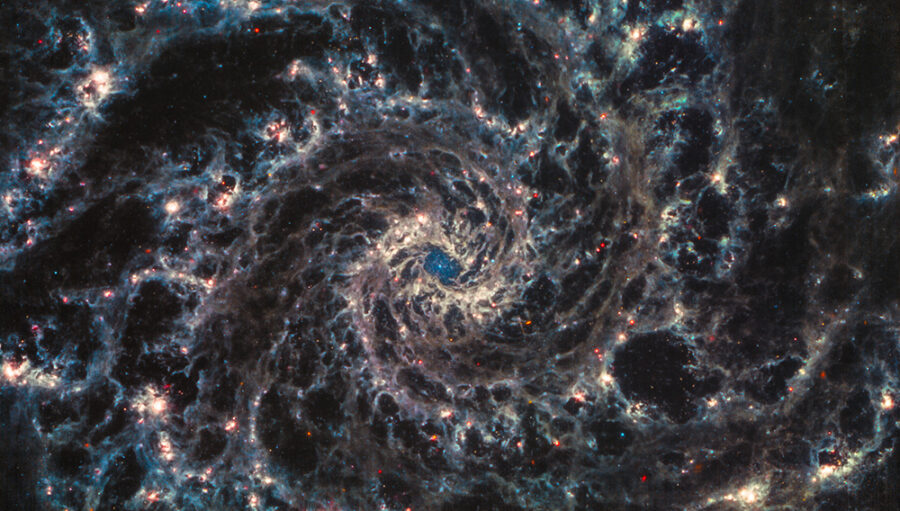
NASA / ESA / CSA / Judy Schmidt
With more than a dozen galaxies still to be imaged as part of PHANGS, and many more celestial views to come besides, it’s easy to feel a bit like a kid at the astronomical eye candy store!
 1
1









Comments
Anthony-Mallama
August 28, 2022 at 11:17 am
I noticed that the annotated picture of Jupiter indicates "Io's footprint". This is the location where an electric current connecting the satellite and the planet generates the aurora. An amazing picture and a wonderful news article!
You must be logged in to post a comment.
You must be logged in to post a comment.